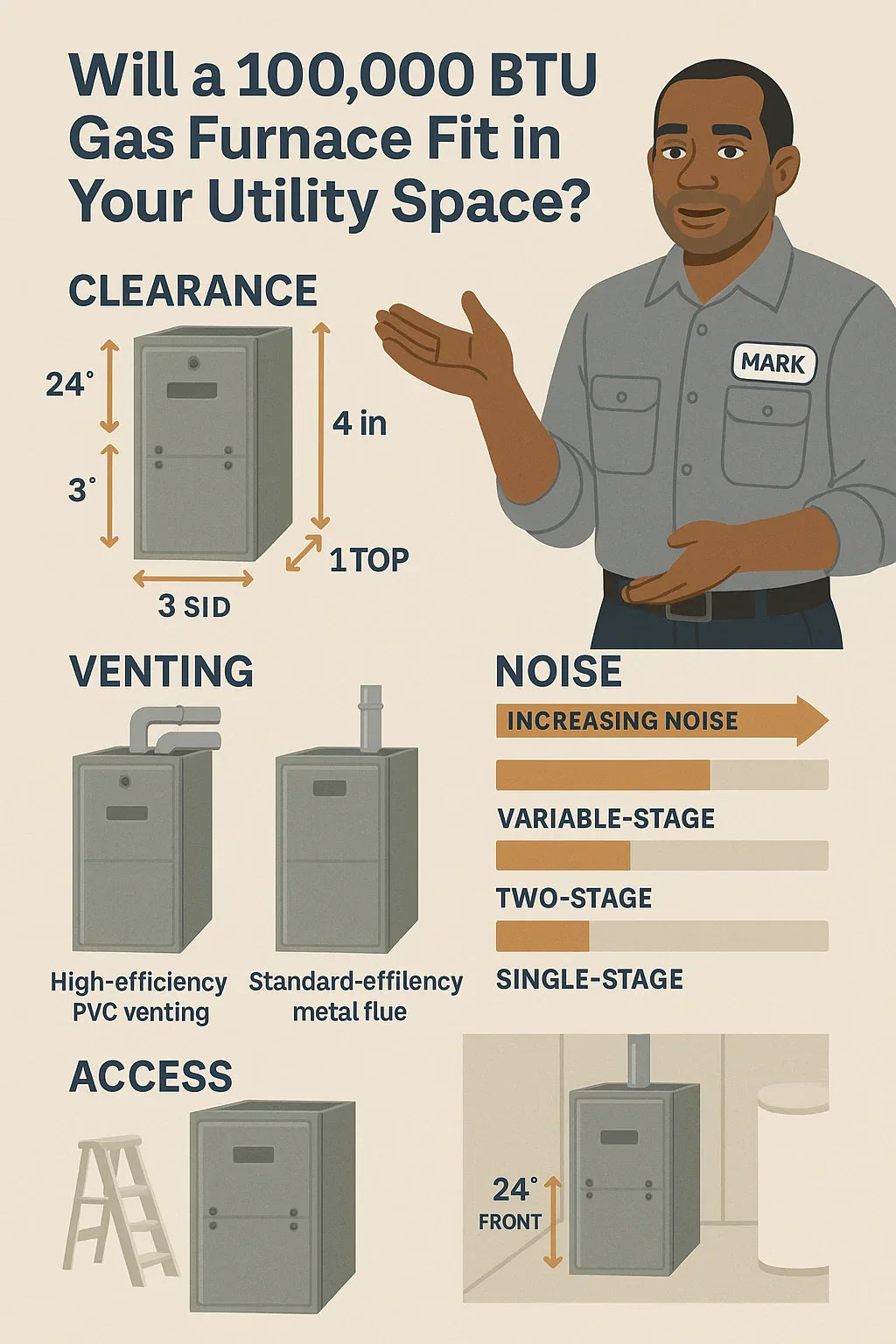1. 🏠 Why Space Matters for Furnace Performance
When I bought my 100,000 BTU R-32-compatible gas furnace, I thought the only decision was capacity and efficiency.
Then my installer walked into my basement and said:
“We’ve got a clearance problem.”
Furnaces don’t just need to fit—they need enough space to breathe, vent safely, and allow for maintenance.
A poorly planned install can mean:
-
Failed inspections due to code violations.
-
Restricted airflow, reducing efficiency.
-
Overheating risks and shorter lifespan.
-
Annoying noise in nearby rooms.
2. 📏 Measuring Your Utility Space
Before you even shop for a furnace, measure your space. Don’t just measure the floor area—account for:
-
Length, width, height (floor to ceiling).
-
Clearance from walls on all sides.
-
Doorway size (getting the furnace in is step one).
-
Ductwork location—supply and return take up space above/around the unit.
-
Coil height if pairing with R-32 AC/heat pump.
Pro Tip: Leave extra inches beyond manufacturer minimums for comfort during installation and future service.
3. 🛡 Code & Manufacturer Clearance Requirements
Clearances are required for:
-
Airflow into combustion and blower areas.
-
Heat dissipation around the cabinet.
-
Technician access for repairs.
Typical Minimum Clearance for a 100,000 BTU High-Efficiency Furnace:
-
Front: 24 inches (for service access).
-
Sides: 1 inch (non-combustible), 3 inches (combustible).
-
Rear: 0–1 inch (depends on model).
-
Top: 1 inch (non-combustible).
-
Venting: per manufacturer’s vent table.
4. Venting Considerations
Your venting method will shape your space requirements.
High-Efficiency (90–98% AFUE) Furnaces:
-
Use PVC vent pipes through the sidewall or roof.
-
Require slope for condensate drainage.
-
Need space for condensate pump/drain line.
Standard-Efficiency (80% AFUE):
-
Use metal flue (B-vent) up through the roof.
-
Require vertical clearance for flue rise.
R-32 Consideration:
If your furnace houses the cooling coil for an R-32 AC or heat pump, make sure the coil drain pan and refrigerant line connections are accessible.
5. 🔊 Noise Factors in Utility Space
Furnace noise comes from:
-
Blower motor (air movement).
-
Burner ignition.
-
Airflow turbulence in ducts.
Noise Levels by Type:
-
Single-stage: Louder (full speed every cycle).
-
Two-stage: Quieter (low stage most of the time).
-
Variable-speed: Quietest (ramps up slowly).
Soundproofing Tips:
-
Install an insulated door to the utility room.
-
Use lined ductwork for the first few feet from the furnace.
-
Add acoustic panels to walls if the furnace is near living areas.
6. 🚪 Accessibility for Maintenance & Repairs
A furnace may run for 20+ years, but it will need regular service:
-
Filter changes (monthly/quarterly).
-
Blower cleaning.
-
Igniter or flame sensor replacement.
Technicians need clear working space:
-
At least 24 inches clearance in front.
-
Room to remove blower, coil, or control board.
Crowded installs increase labor time—and your repair bills.
7. 💡 Mark’s Installation Checklist for Tight Spaces
-
Measure everything—including the path from the delivery truck to the furnace location.
-
Check manufacturer’s clearance table before purchase.
-
Plan vent & drain routing before the unit is in place.
-
Allow for coil height if pairing with R-32 AC.
-
Factor in noise—especially for townhomes, condos, and bedrooms nearby.
-
Leave extra space—minimums are not comfort-friendly for techs.
8. 📋 Case Studies
Case 1: Basement with Low Ceiling
-
Clearance above unit was only 2 inches—installer had to use compact coil to fit.
Case 2: Townhome Utility Closet
-
100,000 BTU two-stage furnace fit with exact side clearance—service access tight but manageable.
Case 3: Garage Corner
-
Plenty of space, but vent route had to be modified to avoid exterior ice buildup.
9. 🔗 External References
Mark’s Final Word:
“A 100,000 BTU gas furnace can fit in a surprisingly small space—but fit doesn’t just mean dimensions. Plan for clearances, venting, noise, and maintenance access, or you’ll regret it later.”
In the next topic we will read more about: Can You DIY a Gas Furnace Replacement? What Mark Learned About Tools, Skills & Safety







